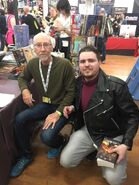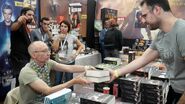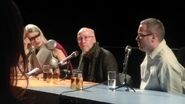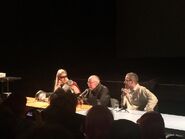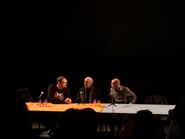Steven Erikson (born October 7, 1959) is the pseudonym of Steve Rune Lundin, a Canadian novelist, who was educated and trained as both an archaeologist and anthropologist.
His best-known work is the ongoing fantasy series Malazan Book of the Fallen, which by 2006 had sold over 250,000 copies.[1][2] SF Site has called the series "the most significant work of epic fantasy since Donaldson’s Chronicles of Thomas Covenant,"[3] and Fantasy Book Review described it as "the best fantasy series of recent times."[4] Fellow fantasy author Stephen Donaldson, refers to Erikson as "an extraordinary writer".[2] In an interview with sffworld.com, Erikson acknowledged that he originally doubted the series would become "mainstream", and was subsequently surprised at how successful the series has been.[5] He also noted how people "either hate the series or love it".[5]
Biography
Steven Erikson was born in Toronto, Canada, and grew up in Winnipeg.[6] He subsequently lived in the UK with his wife and son[6] before returning to Canada to live in Victoria, B.C. in 2012.[7][8] When Erikson moved to the UK with his English wife in 1995, due to a lack of opportunities in the field of archeology, he worked for a time in the communications department of the Toyota UK head office in Redhill.[9] According to an older interview his role was that of a kind of temp in the communications department and he lived in Dorking at the time.[10]
He is an anthropologist and archaeologist by training and is a graduate of the Iowa Writers' Workshop.[11] For his thesis at the Iowa Writers' Workshop, Erikson wrote a "story cycle" of short stories titled A Ruin of Feathers about an archaeologist in Central America. Subsequently, Erikson received a grant to finish the work which was published by TSAR, a small Canadian publishing house. For his next work Erikson co-won the Anvil Press International 3-Day Novel Contest for which he signed away the rights, a mistake he attributes to inexperience. Erikson's third book was also published by TSAR, and consisted of a novella and short stories titled Revolvo and other Canadian Tales. Later, upon moving to England, Erikson sold what he refers to as his "first real novel" to Hodder and Stoughton — This River Awakens — written when he still lived in Winnipeg. The first four books were published under Erikson's real name, and are currently out of print.[12] In addition to writing, Erikson paints using oil paints.[12]
Malazan Book of the Fallen series
Conception

Ian C. Esslemont (left) and Steven Erikson (right), Mud Portage, NW Ontario in about 1983. This was the archeological dig they first met on
Steven Erikson and Ian Cameron Esslemont first met at an archeological dig at the site of Mud Portage, Ontario, Canada. According to Steven Erikson, they didn't role-play until their second season there, when Cam introduced AD&D. Erikson remembered that they failed at it in "spectacular, drug-induced fashion".[13]
The Malazan world was devised by Erikson and Esslemont initially as a setting for a role-playing game.[14][15] Gardens of the Moon began as a movie script but evolved into a novel, which Erikson completed in 1991-92 but failed to sell.[16]
In the late 1990s, Transworld - a division of Random House - bought Gardens of the Moon and requested Erikson write additional books in the series.[10] Using the history of the Malazan world he created with Esslemont, Erikson plotted nine additional novels. After the publication of Gardens of the Moon, reviews spread via the internet, and Orion publications attempted to lure Erikson away from Transworld. However, Transworld retained an option on additional novels in the series and offered £675,000 for the remaining nine books of the series.[10]
Style
Gods are always messing with mortals in Erikson's work, but the mortals also, by their patterns of belief, create their own gods, their own greater powers. Everything is in flux. Men and women ascend to godhood; gods die or lose their powers.... It's a messy, complicated business, and there are no easy answers, or clear heroes.
Erikson has stated explicitly that he enjoys playing with and overturning the conventions of fantasy, presenting characters that violate the stereotypes associated with their roles.[5] Erikson deliberately began the Malazan Book of the Fallen series mid-plot rather than beginning with a more conventional narrative.[5][14] Erikson's style of writing includes complex plots with masses of characters. In addition, Erikson has been praised for his willingness to kill central characters when it enhances the plot.[6]
Erikson explained that he changed the terminology he used over the course of writing the series, including for example, that of some units of length. For his full response read his answer to question 37 of the Tor Q&A session[18]
Reception
Word of mouth is very powerful in fantasy, and the net carries its own energy. It made a huge difference – people were picking [Gardens of the Moon] up from Amsterdam to the US.
Erikson's first novel of the Malazan Book of the Fallen series, Gardens of the Moon (1999), was critically acclaimed. It was short-listed for a World Fantasy Award[1] It has also earned him the reputation as one of the best authors in the fantasy genre.[1], and was described as "An astounding début".[2]The novel was acclaimed for its "combination of originality and intelligent, strong and exciting storytelling".[1] The second book in the series, Deadhouse Gates (2000), was voted one of the ten best fantasy novels of 2000 by SF Site.[19]
During a 2008 question and answer session in Seattle, Washington, Erikson stated he had signed a deal to write two more trilogies and six novellas;[20] Erikson planned to use the novellas to continue the Bauchelain and Korbal Broach storyline[21] while one of the trilogies would be a prequel to the main series, detailing the history of Anomander Rake and Mother Dark.[20] During the same interview, Erikson stated that the upcoming book in the main series, Dust of Dreams (which was released in the United Kingdom August 18th, 2009) would be the first novel to end on a cliffhanger.[22]
Adaptations
Some of Steven Erikson's poems from the Malazan books have been set to music by Canadian acoustic alt-folk duo October Gold on their album "Bridge of the Sun".[23] It has also inspired a Salt Lake City based Epic Black Metal band called Caladan Brood, formed by a duo dubbing themselves Mortal Sword and Shield Anvil.[24][25]
Bibliography
As Steven Erikson
Malazan Book of the Fallen series: Novels
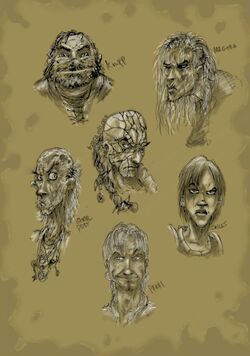
Interpretation of some characters from the Malazan Book of the Fallen by Slaine69
- Gardens of the Moon (1999)
ISBN 0553819577 - Deadhouse Gates (2000)
ISBN 0553813110 - Memories of Ice (2001)
ISBN 0553813129 - House of Chains (2002)
ISBN 0553813137 - Midnight Tides (2004)
ISBN 0553813145 - The Bonehunters (2006)
ISBN 0553813153 - Reaper's Gale (2007)
ISBN 0553813161 - Toll the Hounds (2008)
ISBN 0553824465 - Dust of Dreams (2009)
ISBN 0593046331 - The Crippled God (2011)
ISBN 0593046364
Kharkanas Trilogy
- Forge of Darkness (2012)
ISBN 9780593062180 - Fall of Light (2016)
ISBN 9780593062197 - Walk in Shadow (TBD)
Witness Trilogy
- The God is Not Willing (2019)
- Book 2 (TBD)
- Book 3 (TBD)
Malazan Book of the Fallen series: Novellas
- Blood Follows (2002)
ISBN 159780004X - The Healthy Dead (2004)
ISBN 1597800066 - The Lees of Laughter's End (2007)
ISBN 1905834462 - Crack'd Pot Trail (2009)
ISBN 1848630581 - The Wurms of Blearmouth (2012)
ISBN 1848634773 - The Fiends of Nightmaria (2016)
ISBN 9781786360106 - Upon a Dark of Evil Overlords (TBD)
ISBN TBD - The First Collected Tales of Bauchelain and Korbal Broach (2010)
(Collects Blood Follows, The Healthy Dead, and The Lees of Laughter's End)
ISBN 9780593063958 - The Second Collected Tales of Bauchelain and Korbal Broach (2018)
(Collects Crack'd Pot Trail, The Wurms of Blearmouth, and The Fiends of Nightmaria)
ISBN 9780593063965
Malazan Book of the Fallen series: Short Stories
- Goats of Glory (2010)
ISBN 9780061723810
Non-Malazan
Novels
- Willful Child (2014)
ISBN 059307307X - Willful Child: Wrath of Betty (2016)
ISBN 9780765383907 - Willful Child: The Search for Spark (2018)
ISBN 9780765383969 - Rejoice, A Knife to the Heart (2018)
ISBN 9781473223806
Novellas
- The Devil Delivered (2004)
ISBN 1904619142 - Fishin' with Grandma Matchie (2004)
ISBN 1904619134 - Revolvo (2008)
ISBN 1906301735
Non-fiction
- Writing Fantasy Heroes: Powerful Advice from the Pros (2013) - contributor
ISBN 9780982053683
Poetry
- Tall Boy: A Dialogue of Poems (2020) - Free download from Steven Erikson's official website
As Steve Lundin
Novels
- This River Awakens (1998)
ISBN 0340696370 - When She's Gone (2004)
ISBN 1894283538 - Free download from Steven Erikson's official website
Short stories and novellas
- A Ruin of Feathers (1991)
ISBN 0920661238 - Stolen Voices (1993)
ISBN 189563606X - Revolvo & Other Canadian Tales (1998)
ISBN 0920661580
Trivia
- The Erikson pen name comes from his mother's maiden name.[26] He started using it for his fantasy writing at the request of his original non-fantasy publisher who feared confusing his audience. Erikson chose the name to honour his late mother, a prolific reader who never got to read his published work.[27]
- Erikson cites Stephen Donaldson and Glen Cook as his major influences within fantasy fiction.[28] His interest in fantasy was always in the sword and sorcery sub-genre embodied by Robert E. Howard, Fritz Leiber, and Karl Edward Wagner rather than the epic fantasy of J. R. R. Tolkien.[29] He also cites Frank Herbert's Dune as an inspiration for dropping a reader into a story and forcing them to tread water for quite some time before they are able to piece together the story. The "structure of Gardens of the Moon is ripped off straight from Dune.[30]
- Erikson prefers writing in public places surrounded by people, and frequently acknowledges the pubs, bars, and cafes where he worked at the front of each book.[31] He wrote the entirety of his science fiction novel, Willful Child: The Search for Spark, in under four weeks while on a writing retreat in Opatija, Croatia. He spent 4 to 5 hours every day writing at an outdoor bar without breaks.[32]
- Erikson and Esslemont usually meet once a year at the International Conference on the Fantastic Arts in Orlando, Florida to coordinate details in their books. According to Erikson, the two authors "hang out by the pool, and get drunk, and talk about what we're working on. So we work through some stories there...Often I don't see [Esslemont's] manuscript until the book's been published."[33]
- Although never a soldier himself, Erikson attributes some of his experiences as an archaeologist to his ability to faithfully capture the feel of soldiers at war. Field work often involved being isolated with small groups of people in otherwise difficult and unpopulated environments. "Bush fever" once caused one of his coworkers to attack him with a hatchet "because I said the wrong thing at the wrong time." After a dig in Belize in 1983, Erikson visited Honduras, Nicaragua, and Guatemala. Guatemala was in the midst of a civil war and Erikson was witness to its brutality before he could find his way back to Belize.[34]
- Erikson is a long time fencer and finds the acrobatic sword fighting styles common in fantasy television and movies to be unrealistic and ineffective. Using a fencing epee, he once handily defeated a champion from the Society for Creative Anachronism who was armed with a rapier and parrying blade.[35]
- Erikson once wrote a script for the television series, Star Trek: The Next Generation, but it was ultimately rejected. He summarised the plot as:
"A giant last surviving alien in a sleeper ship over a dead planet. Enterprise inadvertently awakens him. In so doing, the alien informs them that he represents a flytrap for an old enemy, who's now on the way. On the planet below, cities rise from beneath earth, revealing a vast thriving civilization. The old enemy appears -- the Doomsday machine. Picard and co beg the alien to save the planet below, but the planet is the honey in the trap, and the planet-killer must be in the act of destroying it for the alien to strike at its heart, which he does. Picard rails against the terrible loss: only to discover that the civilization is a chimera -- not real. The alien sacrifices himself destroying the planet-killer."[36] - Game developer Bungie approached Erikson to write novels or short stories based on the world of the Destiny video game while it was still early in production. The demands of the property's constantly changing backstory and shifting management teams led Erikson to turn down a $100,000 contract. He did complete a single short story for the project, but it was never published.[37]
- In November 2017, Erikson announced plans on his Facebook page to auction off the names of two characters for his upcoming novel, Rejoice, A Knife to the Heart as part of the Worldbuilders charity.
- Erikson enjoys drawing and painting. Before getting into writing, he wanted to be a comic book artist. But his slow pace meant he had to look for a different way to tell stories.[38]
- During a stop on a 2018 book tour, Erikson stayed in a converted monastery outside Paris. In the backyard having a cigarette, he discovered flint Neanderthal tools over a quarter of a million years old on the ground.[39]
- In an April 2020 interview, Erikson said he had recently pitched a science fiction television series alongside author Bennett R. Coles. As part of the pitch, they produced a feature length pilot script.[40]
Image Gallery
External links
- Steven Erikson's new official website (2018)
- Steven Erikson's old official website
- Steven Erikson's Official Facebook Page
- Reviews at FantasyLiterature.net
- Detailed Biography
- Steven Erikson on Twitter
Essays
- On Authorial Intent
- Steven Erikson's Notes on a Crisis (Part 1 of 11)
- Deconstructing Fiction (for Writers and Readers): Excerpt from Forge of Darkness - Introduction followed by 8 parts
- The World of the Malazan Empire and Roleplaying Games
- The Problem of Karsa Orlong
- Commentary - Endgame Vol. 1 and 2 by Derrick Jensen
- How Robin Hobbs' Assassin's Apprentice Pulls the Rug Out from Under You
- Characterization (Part 1) (Part 2)
- We Don't Talk Like This - Dialogue in Fiction (Part 1) (Part 2)
- In 1983 I was standing in a tiny, blistering hot telephone booth in Belize City…
- Never say never (The process of getting Gardens of the Moon published)
- Writing Process
- Adventures of Erikson and Esslemont as young anthropologists (Part 1) (Part 2) (Part 3)
- Are you with me, Dr. Wu? (Collaborating with Esslemont)
- Erikson's best summer job in archaeology and discussion of cultural evolution
- Archaeology fieldwork as inspiration for the soldier's life
- Olive branches and archaeology fieldwork at Swift Current, Saskatchewan
- Star Trek in the Ethosphere
- Deconstructing the Siege of Pale Aftermath Scene (Essay) (Scene Notes)
- Ancient Astronaut Theorists Say Yes
- Anomander Rake and Point of View (POV Part 1)
- Screw Your Hero, What Does the Sidekick Think? (POV Part 2)
- What, Another Tavern? The Use of Setting in Fantasy
- The Big Idea: Steven Erikson
- Chaos in the Writing Room! The Ongoing Clusterfuck that is Star Trek: Discovery
- Life on Thin Ice: Updating my Progress on The Witness Trilogy
- Insight on Bauchelain and Korbal Broach
Art
Erikson has painted a number of holiday cards featuring his characters (malazanempire.com membership may be required to view some images).
- Bauchelain and Korbal Broach
- Iskaral Pust
- K'Chain Che'Malle K'ell Hunter
- Kruppe - in progress
- Kruppe
- Scillara
Other Digital and Painted Works
- Venus Angel - The God is Not Willing mock cover detail
- Upon a Dark of Evil Overlords cover mockup
- High Priestess of Cattledog Cult of Coltaine
Interviews
- Interview at The SF Site - May 2000
- Interview at Amazon UK - 2000
- Interview at Transworld - 2001
- Interview at Transworld - 2002
- Drosdelnach interview - 2003
- Interview with Wotmania - February 2003
- Q&A with Wotmania - 2003
- Q&A with malazanempire.com (No. 1) - 2003
- Q&A with malazanempire.com (No. 2) - 2003
- Wavnuts chat transcript - 2004
- Interview at Tor.com - circa 2004(?)
- Interview at Deep Magic, Issue 28 - September 2004
- Interview at SFFWorld.com - January 2006
- Interview at Pat's Fantasy Hotlist part 1 - January 2006
- Interview at Pat's Fantasy Hotlist part 2 - February 2006
- Interview in Interzone, Issue 205 - circa 2006
- Interview at Bridlington Press - April 2007
- Interview at Pat's Fantasy Hotlist - August 2007
- Interview at Clarkesworld Magazine - December 2007
- Interview at the Science Fiction Book Club - circa 2007
- Interview at Neth Space - March 2008
- Interview at Fantasy Book Critic - June 2008
- Interview by Jay Tomio - June 2008
- Interview at Fantasy Book Review - September 2009
- Interview at Dark Wolf's Fantasy Reviews - October 2009
- Q&A with malazanempire.com - September/December 2009
- Interview at Pat's Fantasy Hotlist - December 2009
- Interview Magazine Life as a Human - March 2010
- Gardens of the Moon Q&A at Tor.com - September 2010
- Interview at Tor.com Discussion with Steven Erikson and Ian Esslemont - October 2010
- Interview at Fantasy Magazine - January 2011
- Deadhouse Gates Q&A at Tor.com - March 2011
- Interview at The Void - March 2011
- Interview at Elitist Book Reviews - April 2011
- Interview at Pat's Fantasy Hotlist - April 2011
- Interview at Blogcritics - April 2011 (also published at seattlepi.com)
- Memories of Ice Q&A at Tor.com - July 2011
- Interview at Clarkesworld Magazine Discussion by authors, including Steven Erikson on Epic Fantasy part 1 - July 2011
- Interview at Clarkesworld Magazine Discussion by authors, including Steven Erikson on Epic Fantasy part 2 - August 2011
- House of Chains Q&A at Tor.com (Part 1) - November 2011
- House of Chains Q&A at Tor.com (Part 2) - December 2011
- Midnight Tides Q&A at Tor.com - March 2012
- Interview at SFFWorld - May 2012
- Interview at The Breathless Quills - June 2012
- The Bonehunters Q&A at Tor.com - June 2012
- Interview at Better Storytelling - July 2012
- Interview at Tor.com - August 2012
- Reaper's Gale Q&A at Tor.com - November 2012
- Geek's Guide to the Galaxy interview - November 2012
- RedditAsk me anything session - 2013
- Toll the Hounds Q&A at Tor.com - August 2013
- Interview at Adria's News - November 2013
- Interview at The Arched Doorway Audio interview and transcript - April 2014
- Dust of Dreams Q&A at Tor.com - June 2014
- The Crippled God Q&A at Tor.com - November 2014
- Authorial Intent Discussion with Steven Erikson (Part I) - 2015
- Authorial Intent Discussion with Steven Erikson (Part II) - 2015
- Reddit Ask me anything session - 2015
- Interview at The Critical Dragon (part 1) - April 2016
- Interview at The Critical Dragon (part 2) - April 2016
- Interview at The Critical Dragon (part 3) - April 2016
- Interview at Inner Worlds on Medium.com - February 2017
- Interview at the Crippled Blog (scroll down for English version) - November 2017
- Multi-author Reddit AYA - November 2017
- Interview at El Caballero Del Arbol Sonriente (scroll down for English version) - December 2017
- Interview in Grimdark Magazine 14 - January 2018
- Interview at Just A Word - May 2018
- Interview at Clarkesworld Magazine - October 2018
- Interview at SFFWorld - October 2018
- Interview at The Fantasy Hive - November 2018
- Interview at Martlet - December 2018
- Interview at Three Crows Magazine - February 2019
Video
- Book Reading and Q&A at University Bookstore (8 parts) - September 2008 (link no longer works - video made private)
- Video interview with SF Bokhandeln - July 2011
- Video interview at Liburnicon - August 2012
- Panel discussion with Tad Williams (7 parts) - November 2014
- Emerald City Comic Con Epic Fantasy Panel video - March 2015
- MojaRijeka.hr video interview (partially in Croatian) - July 2015
- Lucca Games 2015 - Videochat con Steven Erikson (translated from Italian) - October 2015
- Read For Pixels 2016 (Fall Edition): Steven Erikson Reading+Q&A Session - September 2016
- Beokon Belgrade Comic Con / Meeting with Honorary Guest Steven Erikson - November 2016
- Steven Erikson talks Star Trek at Can-Con 2017 - October 2017
- Black Gate Magazine video interview - November 2017
- ActusfSite Video Interview at Les Imaginales (questions in French, answers in English) - May 2018
- ActusfSite Video - Imaginales 2018: Meeting with Steven Erikson (questions in French, answers in English) - May 2018
- Librairie Mollat Interview at Imaginales 2018 - May 2018 (French subtitles)
- Babelio Meets Steven Erikson - The 5 Words of Steven Erikson - June 2018
- ActusfSite Video - Utopiales 2018 - November 2018
- Hong Kong Book Fair 2019: Anthropology in World Building - July 2019
Audio/Podcast
- Interview Adventures in Sci-fi Publishing Audio Interview - November 2011
- Geek's Guide to the Galaxy podcast - November 2012
- The Coode Street Podcast - March 2014
- Interview at The Arched Doorway Audio interview and transcript - April 2014
- The Coode Street Podcast - January 2016
- The Grim Tidings Podcast - April 2016 - (see also Scratch)
- Books and More with Lenore podcast - May 2017
- Not A TSACast: Fireside Conversations with Steven Erikson podcast - April 2018
- An Evening with Steven Erikson by Nerdaí Irish Nerds - August 2019
- Ten Very Big Books podcast - Gardens of the Moon - November 2019
- Ten Very Big Books podcast - Deadhouse Gates - February 2020
- Not A TSACast: Fireside Conversations with Steven Erikson Ep#2 podcast - April 2020
Comments attributed to Steven Erikson from book signings and other sources
- Aidan Moher - October 2007
- Malazan Empire Forum - Message March 2008
- Comic Con Portugal - September 2018
The Tor reread
(Note to editors: Do NOT copy from TOR reread to the Wiki)
Other Authors On Steven Erikson and the Malazan series
Public appearances
- Guest of Honour at Fantasycon 2005 30 September - 2 October 2005 (Walsall, UK)
- Book Reading and Q&A at University Bookstore 2008 (Seattle, Washington, US)
- Killing Significant Characters Panelist at World Fantasy Convention 2008 with George R. R. Martin and Tad Williams (Calgary, Canada)
- Guest at Fantasycon 2009 18-20 September 2009 (Nottingham, UK)
- Guest of Honour at Liburnicon 2012 (Opatija, Croatia)
- Guest at the 2013 Celsius 232 Festival (Avilés, Spain)
- Guest at Ad Astra 4-6 April 2014 (Richmond Hill, Ontario, Canada)
- Guest at Kepler's Books Sci Fi/Fantasy Day 2014 (Menlo Park, California, US)
- Guest at the 2015 Emerald City Comic Con (Seattle, Washington, US)
- Guest at MisCon 29 22-25 May 2015 (Missoula, Montana, US)
- Guest of Honour at the 2015 World Fantasy Convention (Saratoga Springs, New York, US)
- Guest at Lucca Comics and Games 2016 (Lucca, Italy) (in Italian)
- Guest at Belgrade Comic Con (Beokon) 4-6 November, 2016 (Belgrade, Serbia)
- Guest of Honour at the International Conference on the Fantastic in the Arts March 2017 (Orlando, Florida, US)
- Guest at Hal-Con 2017 (Halifax, Nova Scotia, Canada)
- Guest of Honour at Can-Con 2017 (Ottawa, Canada)
- Attended International Conference on the Fantastic in the Arts March 2018 (Orlando, Florida, US) SE facebook post 20 Mar 2018
- Attended BC Book Day 23 April 2018 (Victoria, BC, Canada)
- Guest at Les Imaginales (Festival)[41] 24-27 May 2018 (Epinal, France)
- Literature Guest of Honour at Liburnicon 17-19 August 2018 (Opatija, Croatia)
- Guest at Comic Con Portugal 6-9 September 2018 (Lisbon, Portugal)
- Guest at VCON 42 6 October 2018 (Vancouver, Canada)
- An Evening with Steven Erikson at McNally Robinson Booksellers 18 October 2018 (Winnipeg, Canada)
- Guest at MCM Comic Con 26-28 October 2018 (London, UK)
- Guest at Utopiales 2018 31 October - 4 November 2018 (Nantes, France)
- Attended International Conference on the Fantastic in the Arts 13-16 March 2019 (Orlando, Florida, US)[42]
- Guest at Hong Kong Book Fair 2019 - conducted Anthropology in World-Building seminar - 18 July 2019 (Hong Kong)
- Guest at Worldcon 77 Dublin 2019 15-19 August 2019 (Dublin, Ireland)
Wikis
- Wikipedia page for Steven Erikson
- Old Malazan wiki (requires registration to edit)
Notes and references
- ↑ 1.0 1.1 1.2 1.3 Steven Erikson. booksattransworld. Retrieved on 11 July 2009.
- ↑ 2.0 2.1 2.2 Steven Erikson. Retrieved on 11 July 2009.
- ↑ Thompson, William (2004). The SF Site Featured Review: Midnight Tides. The SF Site. Retrieved on 2009-02-22.
- ↑ House of Chains by Steven Erikson. Fantasy Book Review. Fantasybookreview.com (2008). Retrieved on 10 August 2009.
- ↑ 5.0 5.1 5.2 5.3 Interview with Steven Erikson. SFFWorld.com (Jan 21 2006). Retrieved on 11 July 2009.
- ↑ 6.0 6.1 6.2 Steven Erikson biography. Fantasy Book Review. Fantasybookreview.com. Retrieved on 10 August 2009.
- ↑ Penguin Books Author Biography
- ↑ Steven-Erikson.org About the Author
- ↑ Facebook post 3 January 2018
- ↑ 10.0 10.1 10.2 10.3 Moss, Stephen (1999-10-14). Malazans and megabucks. The Guardian. Retrieved on 2009-02-22.
- ↑ Steven Erikson. Macmillan (2008). Retrieved on 11 July 2009.
- ↑ 12.0 12.1 Vandermeer, Jeff (2008). Steven Erikson: No Lies, No Holding Back. Clarkesworld Magazine. Retrieved on 31 August 2009.
- ↑ Facebook post 29 December 2017
- ↑ 14.0 14.1 On the spot at Bookspotcentral: Interview with Steven Erikson. bookspotcentral.com. Retrieved on 11 July 2009.
- ↑ Erikson Q & A - Part 6
- ↑ Gardens of the Moon review at Science Fiction Book Club
- ↑ Leonard, Andrew (2004-06-21). Archaeologist of lost worlds. Salon.com. Retrieved on 2009-02-22.
- ↑ Steven Erikson (2014) Ask Steven Erikson Your Crippled God Questions!, Tor Blogs, Macmillan, Accessed: 16-12-2014, Available: <http://www.tor.com/blogs/2014/11/steven-erikson-the-crippled-god-q-and-a>, see Steven Erikson's answer to question 37
- ↑ Top ten books of 2000. SF Site.
- ↑ 20.0 20.1 Erikson Q & A - Part 7. YouTube.
- ↑ Steven Erikson interview. Fantasy Book Critic.
- ↑ Steven Erikson Q & A - Part 5. YouTube.
- ↑ October Gold - Bridge of the Sun"
- ↑ Caladan Brood Bandcamp page
- ↑ Caladan Brood Facebook page
- ↑ Q and A with malazanempire No 2 (2003)
- ↑ Ten Very Big Books podcast See 37:10
- ↑ An Evening with Steven Erikson by Nerdaí Irish Nerds See 10:45
- ↑ Ten Very Big Books podcast See 39:50
- ↑ Ten Very Big Books podcast See 51:00
- ↑ Facebook post 12 January 2018
- ↑ Facebook post 28 March 2018
- ↑ An Evening with Steven Erikson by Nerdaí Irish Nerds - See 36:30
- ↑ An Evening with Steven Erikson by Nerdaí Irish Nerds - See 45:25
- ↑ Black Gate Magazine video interview (see 25:20)
- ↑ Reddit AMA 2015
- ↑ Black Gate Magazine video interview (see 31:35)
- ↑ Ten Very Big Books podcast See 34:30
- ↑ Ten Very Big Books podcast See 30:50
- ↑ Not A TSACast: Fireside Conversations with Steven Erikson Ep#2 podcast (See 13:55)
- ↑ Facebook post 24 November 2017
- ↑ Locus Online-2019 ICFA Report
| This page uses Creative Commons Licensed content from Wikipedia (view authors). |



